Coronavirus (COVID-19): modelling the epidemic (issue no.87)
Latest findings in modelling the COVID-19 epidemic in Scotland, both in terms of the spread of the disease through the population (epidemiological modelling) and of the demands it will place on the system, for example in terms of health care requirement.
This document is part of a collection
Coronavirus (COVID-19): modelling the epidemic in Scotland (Issue No. 87)
Background
This is a report on the Scottish Government modelling of the spread and level of Covid-19 in Scotland. This updates the previous publication on modelling of Covid-19 in Scotland published on 21st January 2022. The estimates in this document help the Scottish Government, the health service and the wider public sector plan and put into place what is needed to keep us safe and treat people who have the virus.
This edition of the research findings focuses on the epidemic as a whole, looking at estimates of R, growth rate and incidence as well as local measures of change in the epidemic.
We also include an overview of Covid 2021 based on our modelling outputs. This includes R, medium term projections, risk of severe outcomes, contact patterns and waste water. It updates the overview provided in issue 31 of our publication of the week of 14th December 2020[1].
Key Points
- The level of Covid-19 in Scotland has varied across 2021 with a period dominated by Alpha, a period dominated by Delta and a period when Omicron became dominant.
- Over 2021, the Scottish Government provided projections on the number of Covid-19 infections, and the number of people in hospital or ICU due to Covid-19. The subsequent actual numbers of these observed were largely within the ranges modelled throughout 2021.
- Those most at risk from Covid-19 over the year were associated with older age, comorbidities, hospitalisation in the previous 4 weeks, high-risk occupations, care home residence, living in a deprived area, being male and being an ex-smoker. Individuals with a history of certain medical conditions (asthma, chronic kidney disease, heart failure, type 2 diabetes, dementia and coronary heart disease) were also identified at being at higher risk.
- The reproduction rate R in Scotland is currently estimated as being between 0.7 and 0.9, as of 11th January 2022. The upper limit has decreased since last week.
- The daily growth rate for Scotland is currently estimated as between -8% and -2% as at 11th January. The upper limit has decreased since last week.
- The number of new daily infections for Scotland is estimated as being between 47 and 572 as at 11th January, per 100,000 people.
- Average contacts from the most recent Panel B cohort of the Scottish Contact Survey (week ending 19th January) indicate an average of 5.0 contacts. This is an increase of 35% compared to two weeks prior.
- Mean contacts have increased within the work and other setting (contacts outside home, school and work) by 59% and 10% respectively in the last two weeks. Contacts within the home have decreased by 7% levels over the same period.
- The biggest increase was observed in the 30-39 age group where overall contacts increased by approximately 89%. This increase is largely driven by a rise in contacts within the work setting.
- The biggest changes in the proportion of participants visiting different locations is seen in those visiting another’s home and visiting a healthcare facility . Visits to another’s home decreased from approximately 60% to 40% while visits to a healthcare facility increased from 12% to 21% in the last two weeks.
- Approximately 76% of individuals had taken at least one lateral flow test within the last 7 days for the survey pertaining to the 13th - 19th January, decreasing from 86% two weeks prior.
- 30% of individuals who had taken at least one lateral flow test in the last 7 days did not report the result, with 67% reporting a negative result.
- The future trajectory of infections, hospitalisations, hospital occupancy and deaths is highly uncertain; some Delta infections may also continue. We estimate that daily infections may be between 5,000 and 60,000 in mid-February. This includes the impact of the interventions announced on 14th and 21st December; those announced as being lifted from 17th, 24th and 31st January; and booster take up.
- Modelled rates of positive tests per 100K using data to 24th January 2022 indicate that, for the week commencing 6th February 2022, 22 of the 32 local authorities are expected to exceed 50 cases per 100K with at least 75% probability.
- Nine local authorities are expected to exceed 100 cases per 100K, with at least 75% probability. These are Aberdeen City, Argyll & Bute, Edinburgh, Clackmannanshire, Dundee, East Lothian, Fife, Perth & Kinross, and South Lanarkshire.
- One local authority (Dundee) is expected to exceed 300 cases per 100K, with at least 75% probability. No local authorities are expected to exceed 500 cases per 100K, with at least 75% probability.
- Comparing the weeks beginning 11th January and 18th January, there was an increase in Covid-19 levels in wastewater in five local authorities. This included Edinburgh, Dumfries & Galloway, East Lothian, Midlothian and West Lothian.
- Modelling of long Covid estimates that on 13th February 2022 between 1.1% and 3.0% of the population are projected to self-classify with long Covid for 12 weeks or more after their first confirmed (or suspected) Covid infection in Scotland. The lower limit of the projection of the proportion of the population with long Covid has reduced slightly compared to last week.
Covid in Scotland during 2021
This section gives an overview of Covid 2021 based on our modelling outputs. This includes what has happened with R, medium term projections, risk of severe outcomes, contact patterns and waste water over 2021. It updates the overview provided in issue 31 of our publication of the week of 14th December 2020[2].
Figure 1 shows how cases, hospital admissions and deaths have varied between December 2020 and December 2021. Cases are shown on the left-hand side axis; hospital admissions and deaths are on the right-hand axis.
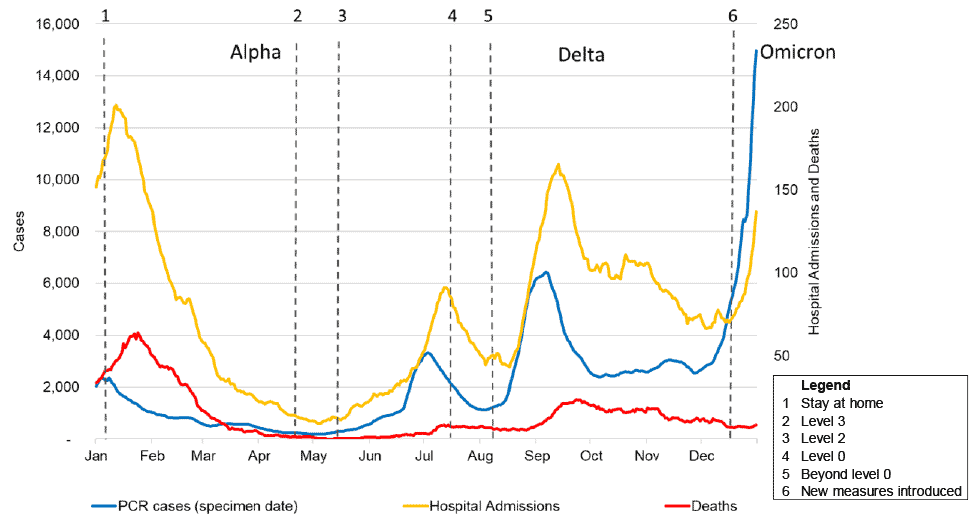
This shows how the level of Covid-19 in Scotland has varied across the year with: a period dominated by Alpha (first reported in Scotland in November 2020[4]), a period dominated by Delta (first reported in Scotland in May 2021[5]) and a period when Omicron became dominant (first reported in Scotland in November 2021[6]).
The estimated peak week for the spread of the infection during the period dominated by Alpha was the week beginning 3rd January 2021 when ONS estimated that 55,700 people in Scotland would have tested positive for Covid-19 (around 1 in 95)[7]. Wastewater COVID-19 levels slowly declined from its peak over the new year period where levels were approximately 65 million gene copies per person per day. The maximum number of 7 day average cases by specimen date during the Alpha wave was 2,348 on 4th January 2021.
The estimated peak week for the spread of the infection during the period dominated by Delta was the week beginning 5th September 2021 when ONS estimated that 120,800 people in Scotland would have tested positive for Covid-19 (around 1 in 45)[2]. Wastewater COVID-19 levels also peaked in this period, with levels approximately between 200 and 300 million gene copies per person per day, up to three times the previous maximum. The maximum number of 7 day average cases by specimen date during the Delta wave was 6,439 on 6th September 2021.
The peak of the period dominated by Omicron had not yet been met by the end of 2021. At the end of 2021 the number of confirmed cases, the ONS estimate of positives and the wastewater data all suggested that the number of infections was continuing to increase. A future update will cover the rest of the Omicron wave.
Reproduction number
Figure 2 provides a time series of the SPI-M-O consensus estimate of the reproduction number R in Scotland from the start of December 2020 to the end of December 2021. Please note that R is an indicator which lags by two or three weeks.
This shows how R has varied through 2021 from its highest point published on 1st September 2021 when the upper limit was estimated to be 1.6, to its lowest point on 10th March 2021 when the lower limit was estimated to be 0.6.
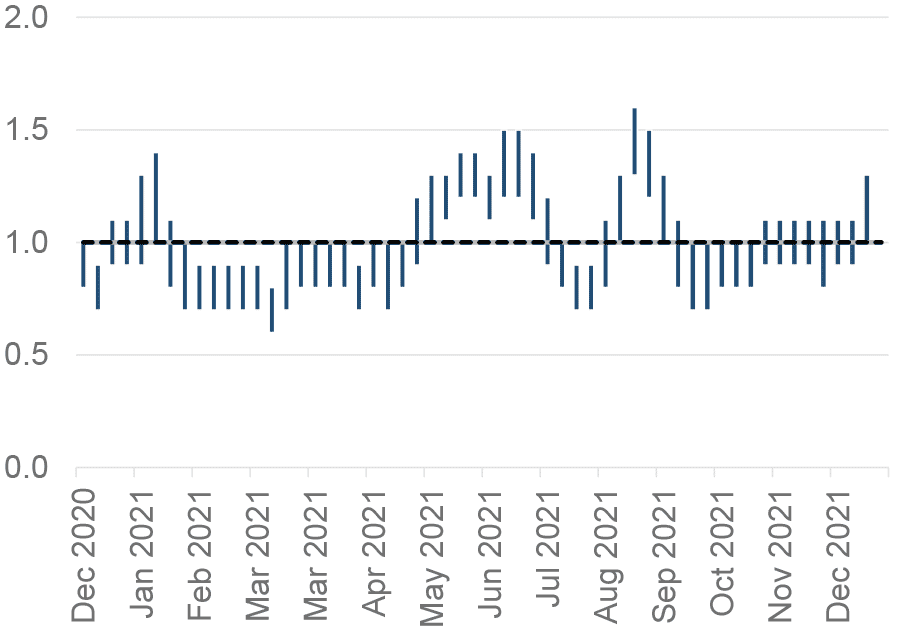
Medium-term modelling across 2021
Across 2021 medium term projection modelling (that is, one to two weeks ahead) was undertaken to estimate what the next few weeks of the epidemic would look like. This gives a fuller picture on total infections, which would not be evident by just looking at case numbers. Our wastewater analysis and the results of the ONS Covid Infection Survey are also useful in this regard.
The following figures show how these medium-term modelling projections performed in comparison to estimates of the actual data following them being estimated.
The actual number of infections were largely within the ranges modelled throughout 2021.
However at the start of the year, the actual infections were higher than expected in the modelling due to the effects of the Alpha variant. From mid-February 2021 to April 2021, the number of infections was lower than expected in the modelling.
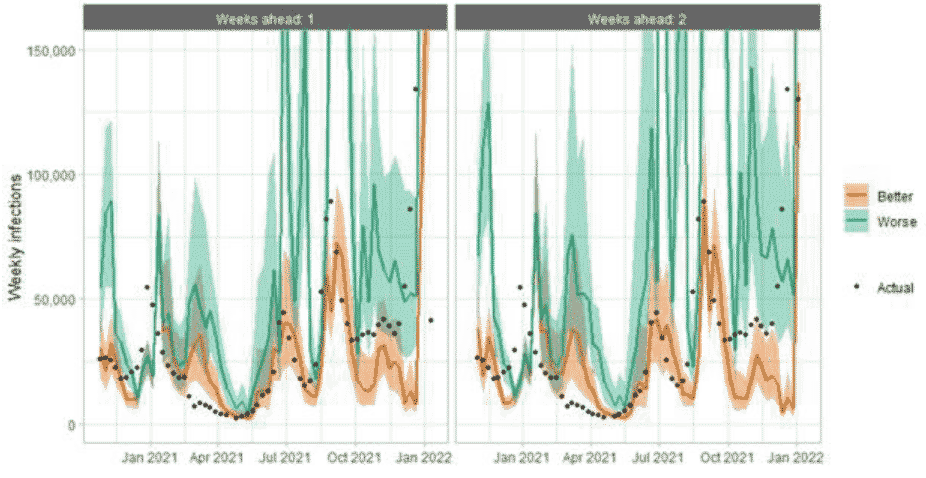
The actual number of hospital beds has been in general within model ranges. The projections are for number of people in hospital due to Covid-19, which is slightly different to the actuals, which are number of people in hospital within 28 days of a positive Covid-19 test.
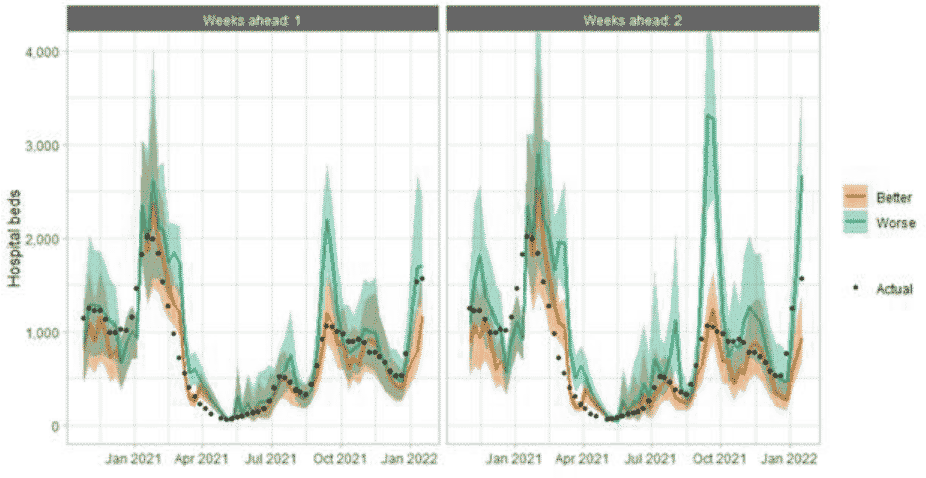
As with hospital beds, the actual number of ICU beds has in general been within model ranges. The projections are for number of people in ICU due to Covid-19. The actuals are number of people in ICU within 28 days of a positive Covid-19 test up to 20 January 2021, after which they include people in ICU over the 28 day limit.
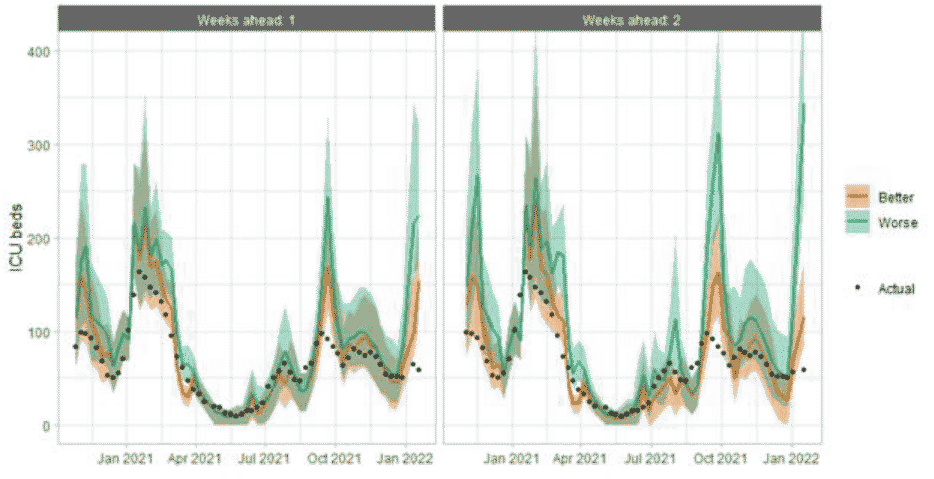
Looking at the year as a whole, there is a very good match between the modelling undertaken and following this the actual number of ICU beds. There is however a period in October 2021 where the number of ICU beds were lower than expected. This also occurred at the end of December 2021 when Omicron was dominant.
In addition, each week we usually present the SPI-M-O projections of the epidemic, showing the projection of deaths and hospitalisations in a scenario where the trajectory of the epidemic follows the trends seen in recent data[8]. These combine estimates from several independent models covering hospitalisation and deaths.
Figures 6 and 7 show the SPI-M-O projections of hospitalisations from July to November 2021 and deaths from August to November 2021, against the actual values subsequently observed. The red dots indicate the data from before the projections begin, and the black dots the data since. Please note some of the data in red has been revised since these projections were produced.
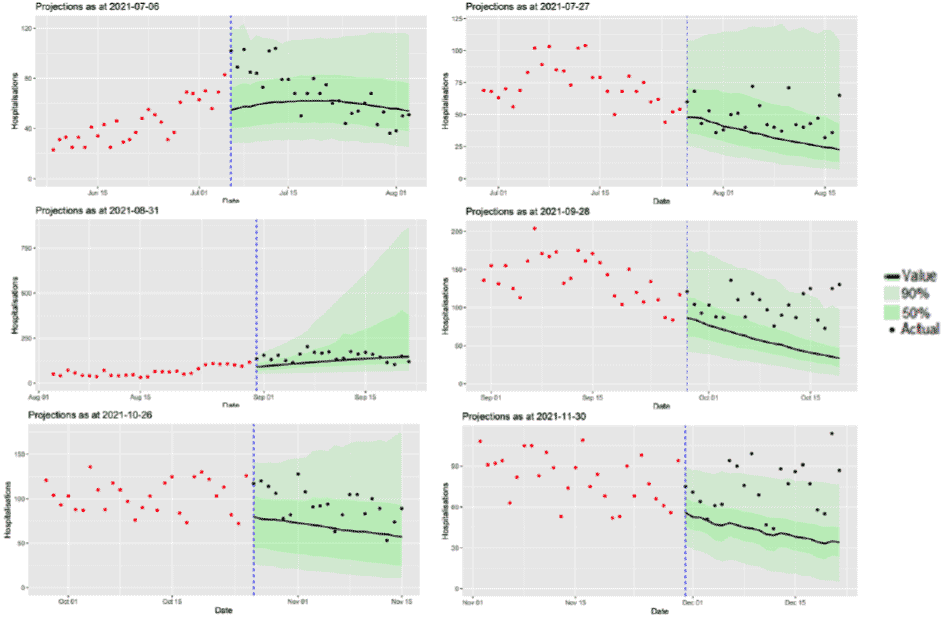
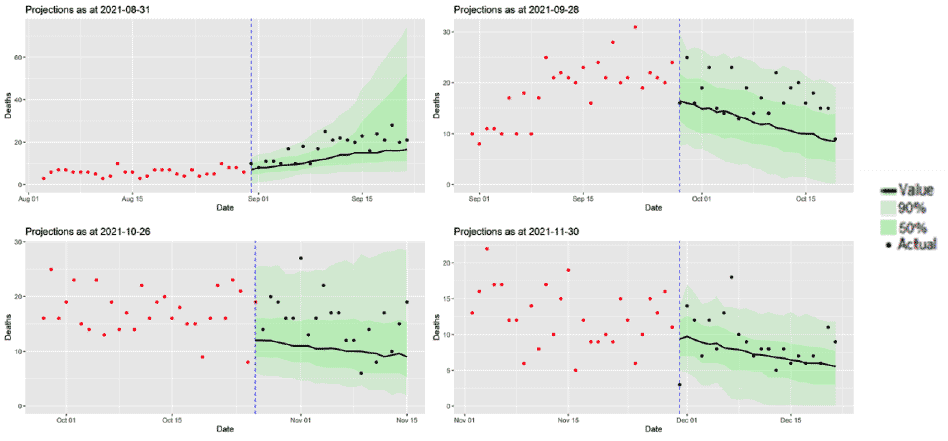
By comparing the estimates with the actuals, Figures 6 and 7 show projections of hospitalisations and deaths from SPI-M-O mostly followed the trends seen in the actual data.
Contacts
Figure 8 shows the average daily contacts across 2021 for all age groups. This shows that the lowest number of contacts occurred in January 2021 before slowly increasing before dropping back at the end of the year.
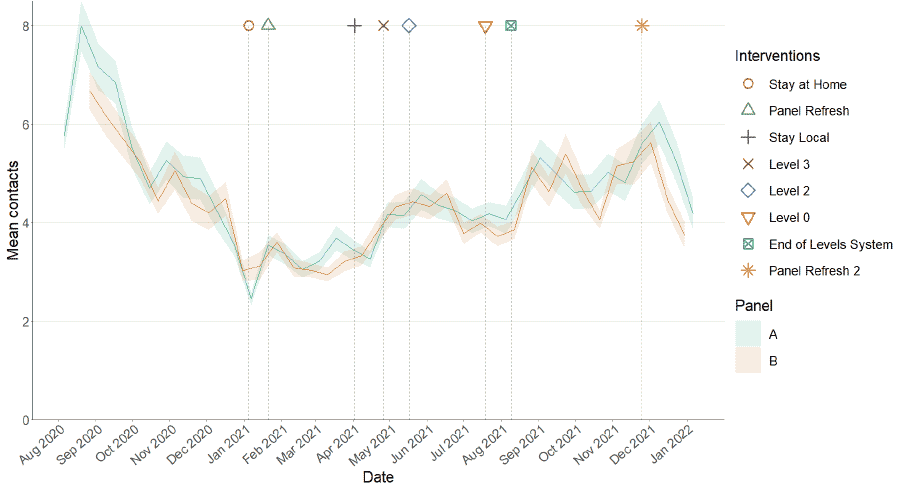
Wastewater
Throughout 2021, levels of Covid-19 RNA in wastewater (WW) were collected at a number of sites around Scotland, adjusted for population and local changes in intake flow rate (or ammonia levels where flow is not available) and compared to 7-day average daily new case rates derived from Local Authority and Neighbourhood (Intermediate Zone) level aggregate data.
Figure 9 shows the national running average trend (over a 7-day period) for the full set of sampled sites, with a small number of unrealistically large outliers excluded.
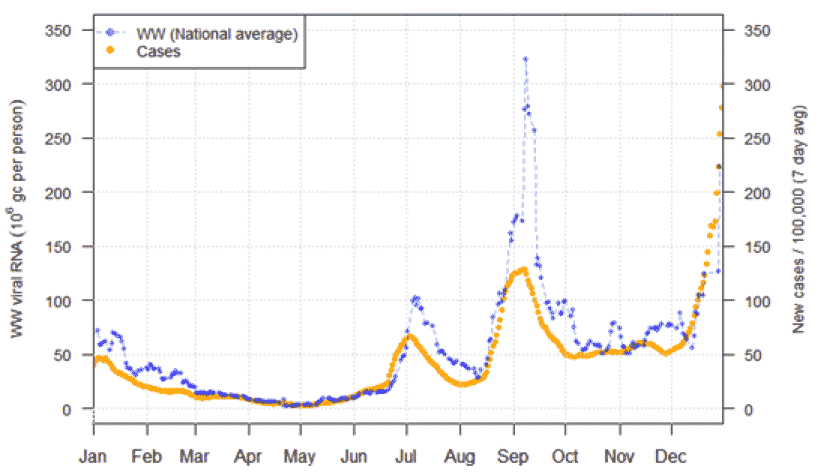
Wastewater COVID-19 levels slowly declined from the start of January 2021, reaching a lowest point at the start of May before slowly rising. A rapid rise began in late June, reaching a peak around that which was experienced at the start of the year. Levels declined to under 50 million gene copies per person per day until mid-August, at which point a second rise took place to very high levels, up to three times the previous maximum. Levels quickly declined however, and fluctuated at around 50 to 80 Mgc/p/d from October to Mid-December. After that, as Omicron became more prevalent in December, levels rose rapidly again. This is reasonably consistent with what was seen in the ONS CIS and the level of infections in the medium term projection modelling shown in Figure 5.
Risk of severe outcomes
The EAVE II Study Group looked at the pattern of demographics and clinical risk groups across 2021 for those who tested positive in Scotland.
In the first week of February 2021[9], it was reported that the risk of hospitalisation following a positive test result had been estimated and individuals with the Alpha variant[10] were shown to be at increased risk compared to those with the non-new variant. The increased risk of hospitalisation (the ‘hazard ratio’), when adjusted for demographics and clinical characteristics, was estimated to be 1.63 (95% CI 1.48, 1.80), for those with the Alpha variant[11].
The proportion of people testing positive for Covid-19 aged 40 and above had decreased over the period from the beginning of January to April 2021[12]. Furthermore, the proportion of people testing positive who were not categorised as being in any clinical risk group rose from around 55% in November 2020 to over 70% in mid-April 2021. The roll-out of the vaccination programme will account for some of this change, as a result of the priorities recommended by JCVI[13].
In the week of 26th April we summarised[14] the findings of a major study published in the Lancet[15]. Four weeks after receiving a first dose, the Pfizer-BioNTech vaccine was shown to reduce the risk of COVID-19 hospitalisation by 91% (95% CI 85–94), and the Oxford-AstraZeneca vaccine by 88% (95% CI 75–94) compared to the unvaccinated. These results show an association with substantial reductions in the risk of COVID-19 hospitalisations across Scotland.
In July 2021[16] we provided an update on the findings of the EAVE II Study Group investigating the risk of hospitalisation from Covid-19 and the estimated vaccine effectiveness in preventing hospital admissions in Delta variant cases.
It showed that unvaccinated Delta variant cases in the community were more likely to be admitted to hospital than unvaccinated Alpha variant cases. Compared to the Alpha variant, the Delta variant is associated with an increase in the risk of Covid-19 hospitalisation by 76% (95% CI 35%-129%).
Two vaccine doses were still expected to provide strong protection against the Delta variant – but potentially at a lower level compared with the Alpha variant.
Vaccines were found to reduce the risk, among those who have tested positive for Covid-19, of being admitted to hospital. The reduction in the risk of hospitalisation was slightly greater for Pfizer than AstraZeneca, though the confidence intervals overlap. At least 28 days after the first dose the risk of hospitalisation was reduced by 72% (95% CI 65%-78%) for Astra Zeneca and 81% (95% CI 74%-91%) for Pfizer.
Amongst individuals tested in hospital labs, vaccination was still associated with a reduced hazard of admission. At least 14 days after the second dose the risk of admission was reduced by 60% (95% CI 52%-77%) which is less than the corresponding figure for community tested individuals; 76% (95% CI 70%-82%).
Further studies from the EAVE II group[17] identified certain groups at higher risk of a serious (i.e. hospitalisation or death) Covid-19 infection. These severe outcomes were associated with older age, comorbidities, hospitalisation in the previous 4 weeks, high-risk occupations (based on taking 10 or more tests weekly vs none), care home residence, living in a deprived area, being male and being an ex-smoker. Individuals with a history of certain medical conditions (asthma, chronic kidney disease, heart failure, type 2 diabetes, dementia and coronary heart disease) were also identified at being at higher risk. Later research[18] showed that for August to October 2021 most hospitalisations were among older double vaccinated individuals. Throughout 2021 we incorporated updated EAVE II assumption, including on severity risk and length of stay, into our regular weekly modelling.
Recent cases
Figure 10 shows the number of Covid-19 cases (from either PCR or LFD[19]) in Scotland over January 2022. The vertical dashed lines indicate the cut off points for each of the modelling inputs; after these dates, the number of cases is not incorporated into the outputs.
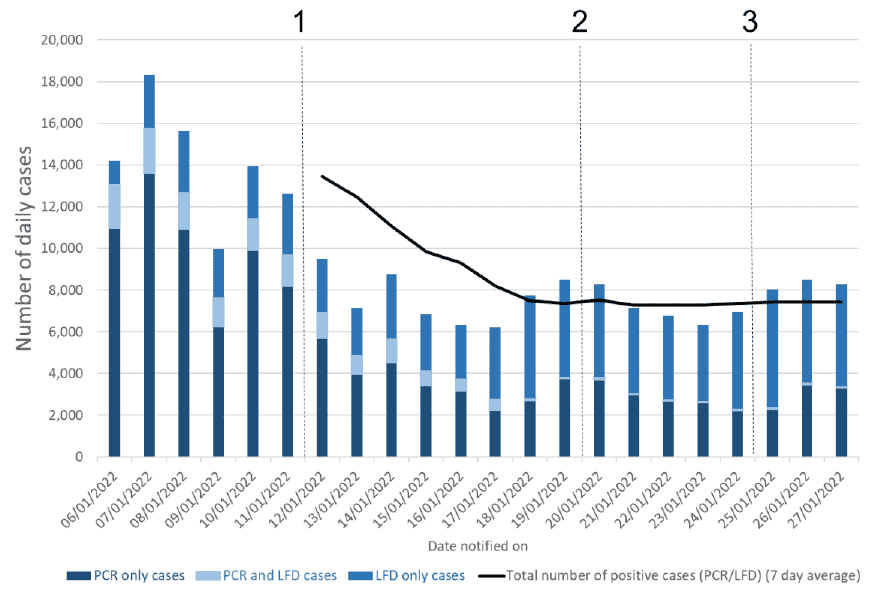
R, growth rate and incidence are as of 11th January 2022 (dashed line 1). The Scottish Contact Survey uses data to 19th January 2022 (dashed line 2). The Scottish Government modelling of infections, the long Covid analysis, the modelled rates of positive tests per 100K and the wastewater analysis use data to 24th January 2022 (dashed line 3).
Overview of Scottish Government Modelling
Modelling outputs are provided here on the current epidemic in Scotland as a whole, based on a range of methods. Because it takes a little over three weeks on average for a person who catches Covid-19 to show symptoms, become sick, and either die or recover, there is a time lag in what our model can tell us about any change in the epidemic.
This week the Scottish Government presented one output to EMRG.
This used modelled infection figures provided by the Covid Infection Survey. This output is included in Figures 11 and 12.
The R value and growth rates are estimated by several independent modelling groups based in universities and the UKHSA. Estimates are considered, discussed and combined at the Epidemiology Modelling Review Group (EMRG), which sits within the UKHSA. These are based on data to 24th January.
UKHSA’s consensus view across these methods was that the value of R in Scotland[21] is between 0.7 and 0.9, as of 11th January 2022[22] (Figure 2).
R is an indicator that lags by two to three weeks.
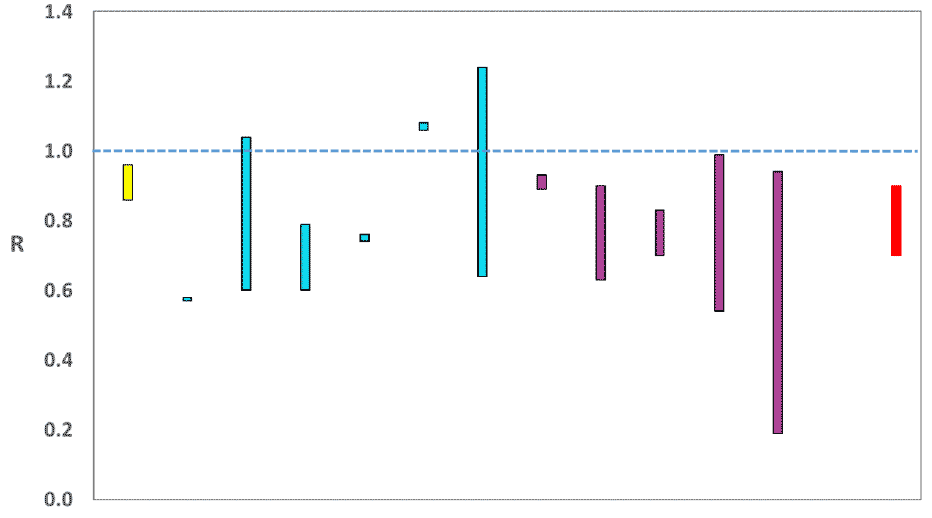
Source: EMRG
The various groups which report to the EMRG use different sources of data in their models to produce estimates of incidence (Figure 12). UKHSA’s consensus view across these methods, as at 11th January, was that the incidence of new daily infections in Scotland was between 47 and 572 new infections per 100,000. This equates to between 2,600 and 31,300 people becoming infected each day in Scotland.
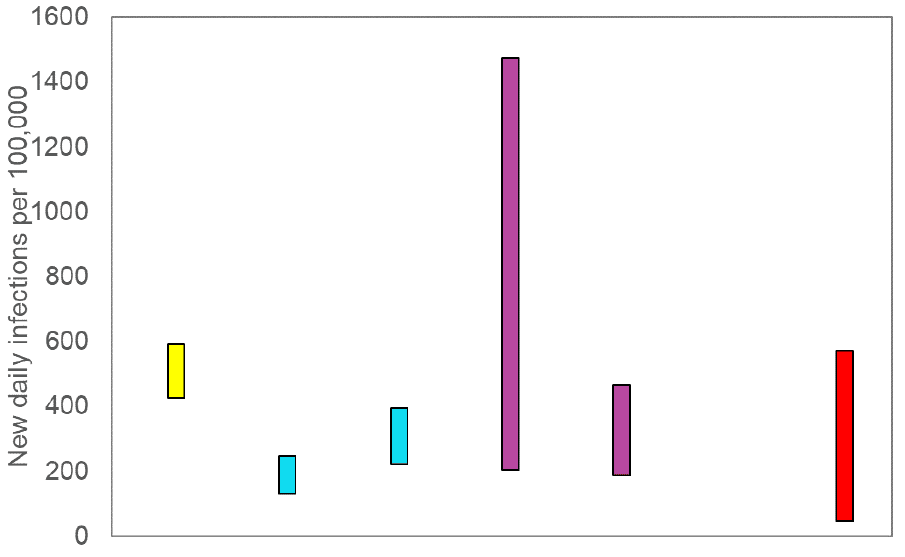
Source: EMRG
The consensus from UKHSA for this week is that the growth rate in Scotland is between -8% and -2% per day as at 11th January. The upper limit has decreased since last week.
What we know about how people’s contact patterns have changed
Average contacts from the most recent Panel B cohort of the Scottish Contact Survey (week ending 19th January) indicate an average of 5.0 contacts. This has increased by 35% compared to the previous Panel B of the survey (week ending 5th January), as seen in Figure 13. Mean contacts have increased within the work and other setting (contacts outside home, school and work) by 59% and 10% respectively in the last two weeks. Contacts within the home have decreased by 7% levels over the same period.
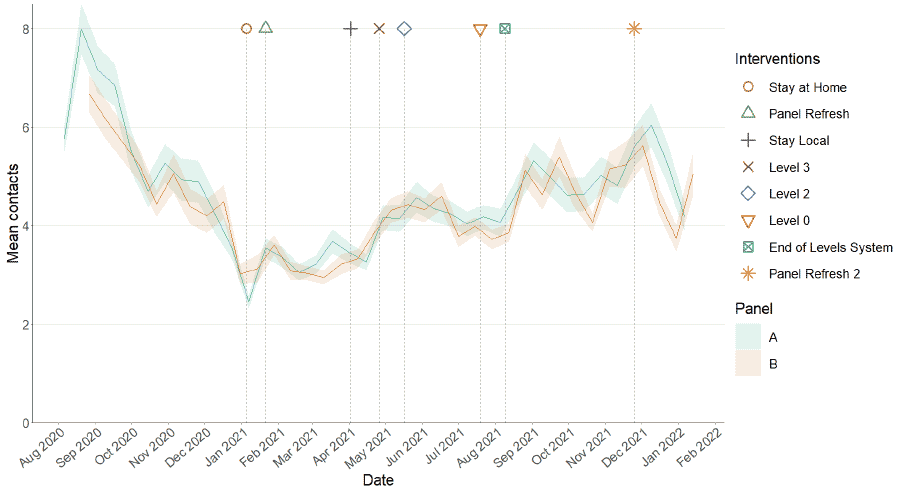
Figure 14 shows how contacts change across age group and setting. All age groups reported an increase in contacts in the last two weeks. The biggest increase was observed in the 30-39 age group where overall contacts increased by approximately 89%. This increase is largely driven by a rise in contacts within the work setting.

The heatmaps in Figure 15 show the mean overall contacts between age groups for the weeks relating to 30th December - 5th January and 13th January - 19th January and the difference between these periods. The biggest increase in interactions between age groups is between those aged 30-39 with individuals under 18, where interactions are at least 3 times higher in comparison to two weeks prior.
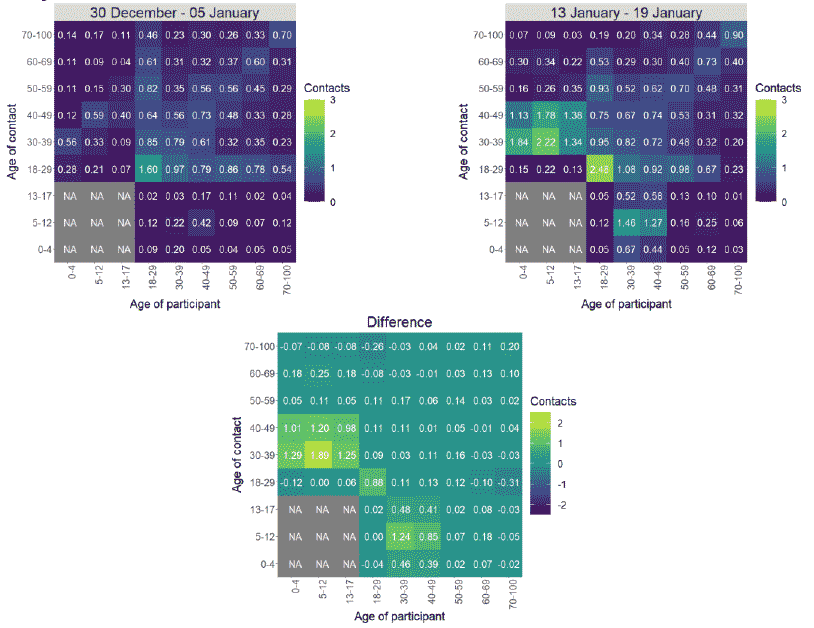
The biggest changes in the proportion of participants visiting different locations is seen in those visiting another’s home and visiting a healthcare facility. Visits to another’s home decreased from approximately 60% to 40% while visits to a healthcare facility increased from 12% to 21% in the last two weeks as shown in Figure 16.
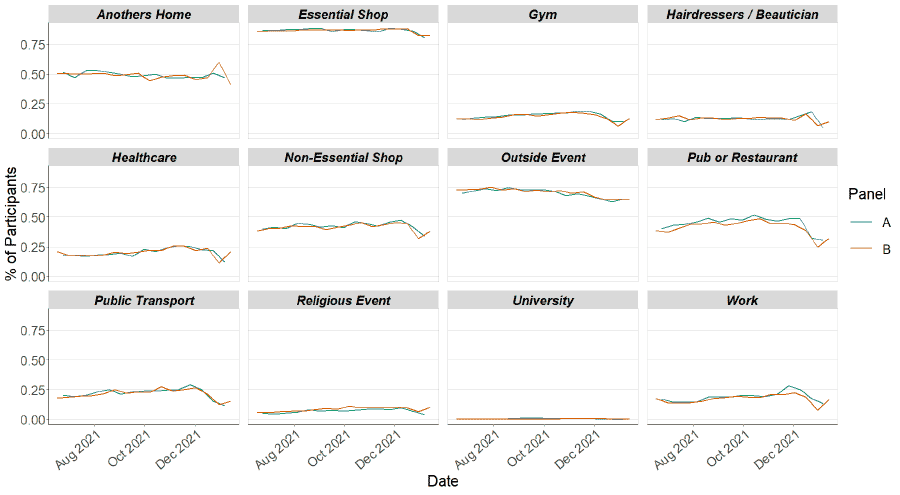
Approximately 76% of individuals had taken at least one lateral flow test within the last 7 days for the survey pertaining to the 13th - 19th January, decreasing from 86% two weeks prior as shown in Figure 17.
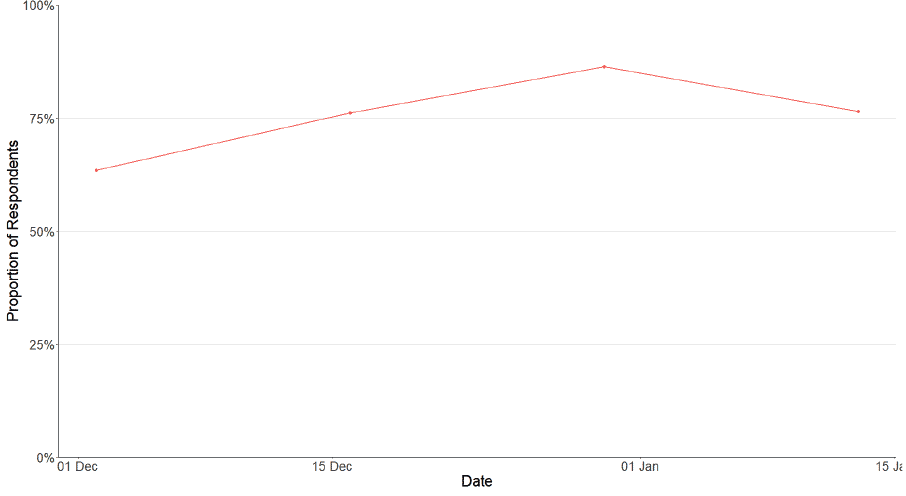
Figure 18 shows that approximately 30% of individuals who had taken at least one lateral flow test in the last 7 days did not report the result, with 67% reporting a negative result.
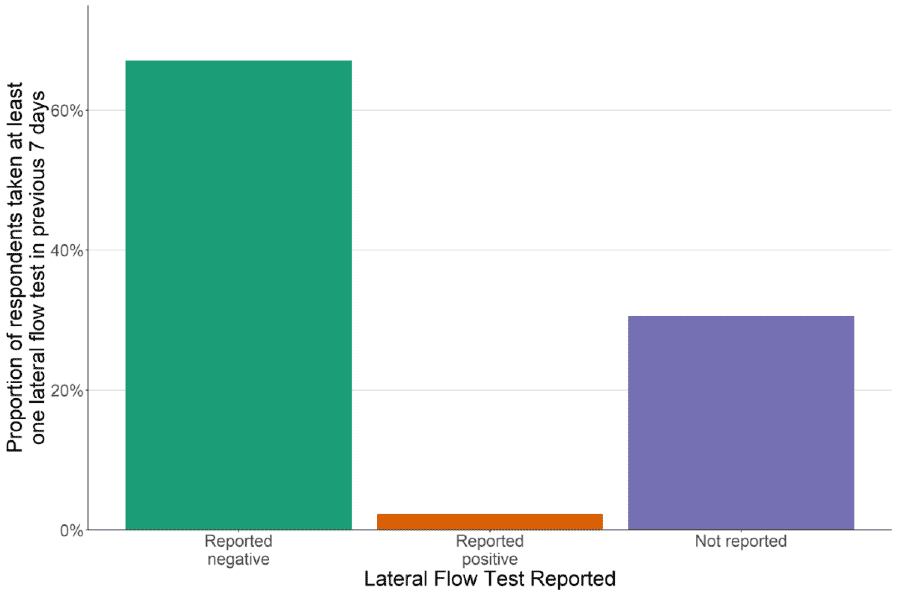
What the modelling tells us about estimated infections
The Scottish Government assesses the impact of Covid-19 on the NHS in the next few weeks, in this research findings we focus on estimating the number of infections. Figures 19 - 21 show projections over the three weeks for combined Delta and Omicron infections.
These projections include the effect of the interventions announced on 14th and 21st December 2021; those announced as being lifted from 17th, 24th and 31st January 2022; and booster take up. ‘Central’ assumes that infections broadly plateau at current levels. ‘Worse’ assumes a higher transmissibility for Covid-19 whereas ‘Better’ assumes a lower transmissibility. All projections also assume a lower vaccine effectiveness[24] for Omicron than for Delta[25].
The future trajectory of infections is highly uncertain.
Following the announcement removing the need for a confirmatory PCR test in some cases we have used combined PCR and LFD reported date data from 6th January.
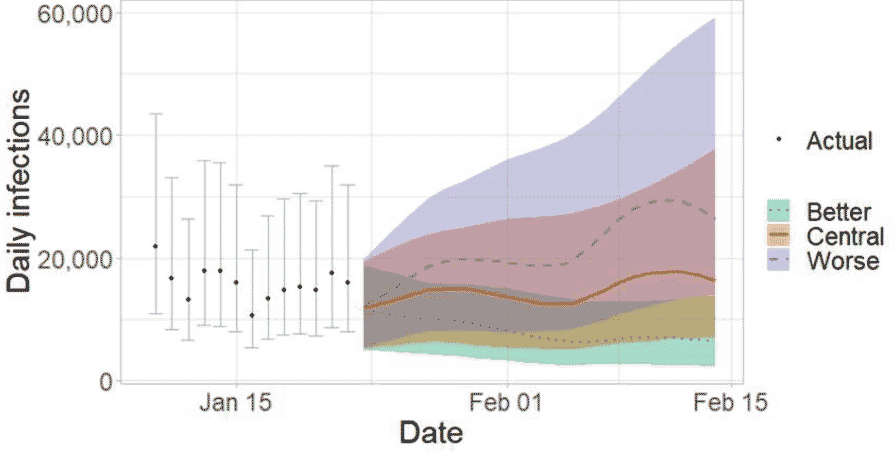
We estimate that daily infections may be between 5,000 and 60,000 in mid-February.
Figure 20 shows the impact of the projections on the number of people in hospital. The modelling includes all hospital stays, whereas the actuals only include stays up to 28 days duration that are linked to Covid-19.
There continues to be uncertainty over hospital occupancy and intensive care in the next three weeks.
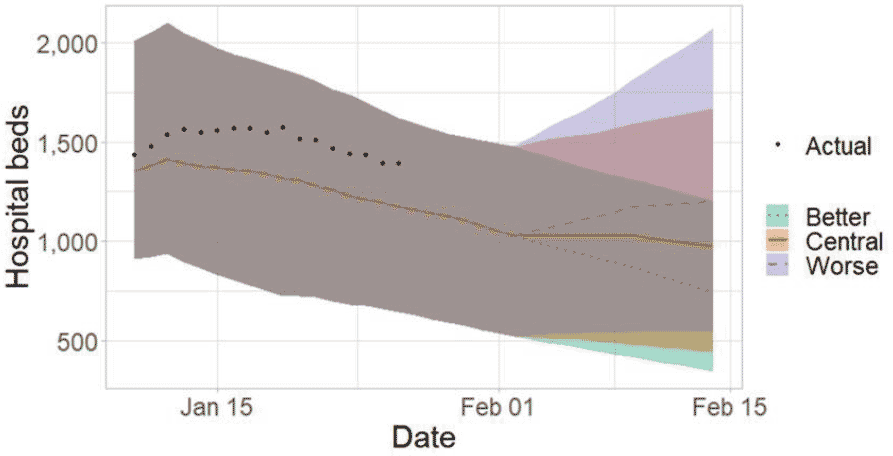
Figure 21 shows the impact of the projection on ICU bed demand.
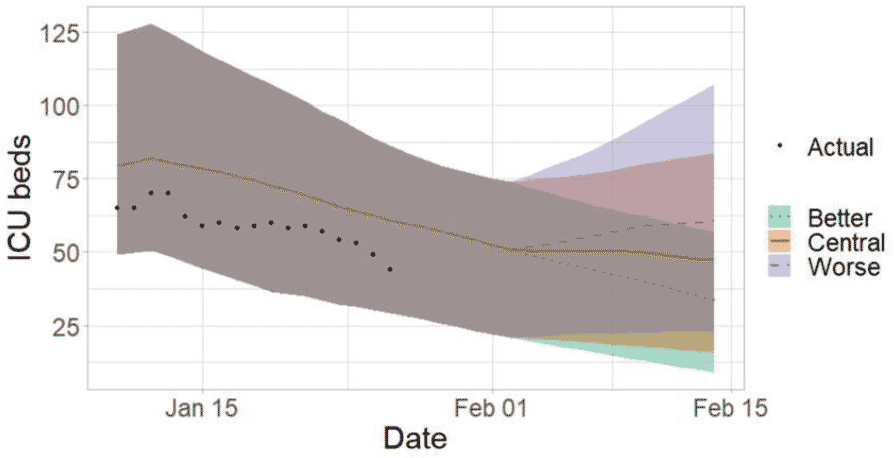
What the modelling tells us about projections of hospitalisations, occupancy and deaths in the medium term
SPI-M-O produces projections of the epidemic (Figures 22 - 24), combining estimates from several independent models. These projections are not forecasts or predictions. They represent a scenario in which the trajectory of the epidemic continues to follow the trends that were seen in the data available to 24th January and do not include the effects of any future policy or behavioural changes.
The delay between infection, developing symptoms, the need for hospital care, and death means they cannot fully reflect the impact of behaviour changes in the two to three weeks prior to 24th January.
The projections include the potential impact of vaccinations over the next few weeks. Modelling groups have used their expert judgement and evidence from UKHSA, Scottish Universities & Public Health Scotland, and other published efficacy studies when making assumptions about vaccine effectiveness.
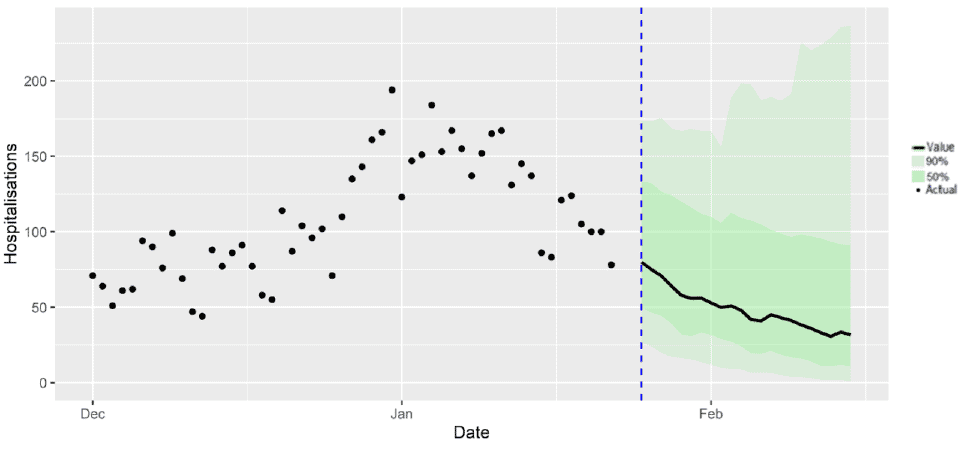
Figure 23 shows the SPI-M-O consensus on hospital occupancy. Hospital occupancy is determined by the combination of admissions and length of stay (LoS), the latter of which is difficult to model with confidence.
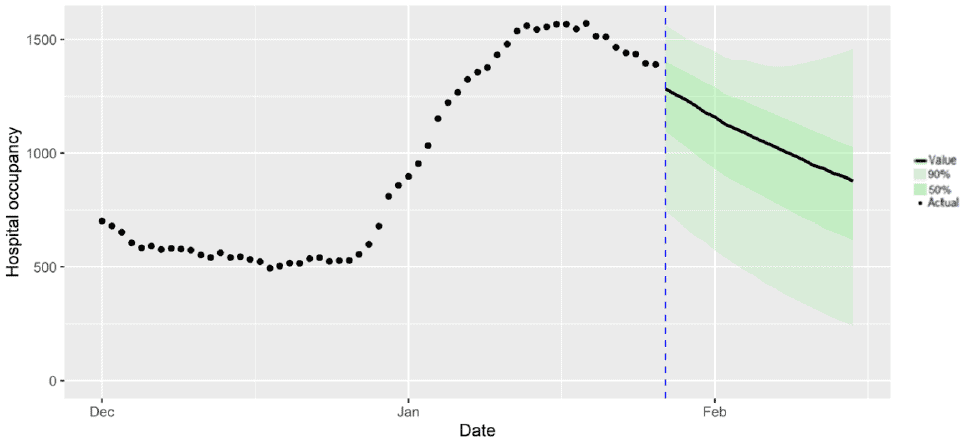
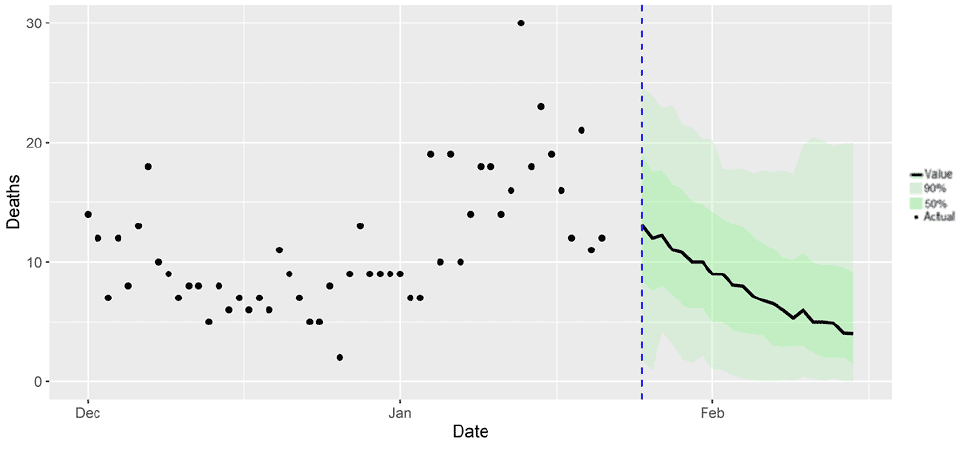
What we know about which local authorities are likely to experience high levels of Covid-19 in two weeks’ time
We continue to use modelling based on Covid-19 cases and deaths using data to 24th January 2022 from several academic groups to give us an indication of whether a local authority is likely to experience high levels of Covid-19 in the future. This has been compiled via UKHSA into a consensus. In this an area is defined as a hotspot if the two week prediction of cases (positive tests) per 100K population is predicted to exceed a threshold, e.g. 500 cases.
There is uncertainty in regions with smaller populations, and hence lower test counts, in particular in regions such as Na h-Eileanan Siar and Shetland Islands. This has led to one model not being included in the combination for these two regions.
Modelled rates of positive tests per 100K using data to 24th January (Figure 25) indicate that, for the week commencing 6th February 2022, 22 of the 32 local authorities are expected to exceed 50 cases per 100K with at least 75% probability. These are Aberdeen City, Argyll & Bute, Edinburgh, Clackmannanshire, Dundee, East Ayrshire, East Dunbartonshire, East Lothian, East Renfrewshire, Falkirk, Fife, Glasgow, Inverclyde, Midlothian, North Ayrshire, North Lanarkshire, Perth & Kinross, Renfrewshire, South Ayrshire ,South Lanarkshire, West Dunbartonshire, and West Lothian.
Nine local authorities are expected to exceed 100 cases per 100K, with at least 75% probability. These are Aberdeen City, Argyll & Bute, Edinburgh, Clackmannanshire, Dundee, East Lothian, Fife, Perth & Kinross, and South Lanarkshire.
One local authority (Dundee) is expected to exceed 300 cases per 100K, with at least 75% probability.
No local authorities are expected to exceed 500 cases per 100K, with at least 75% probability.
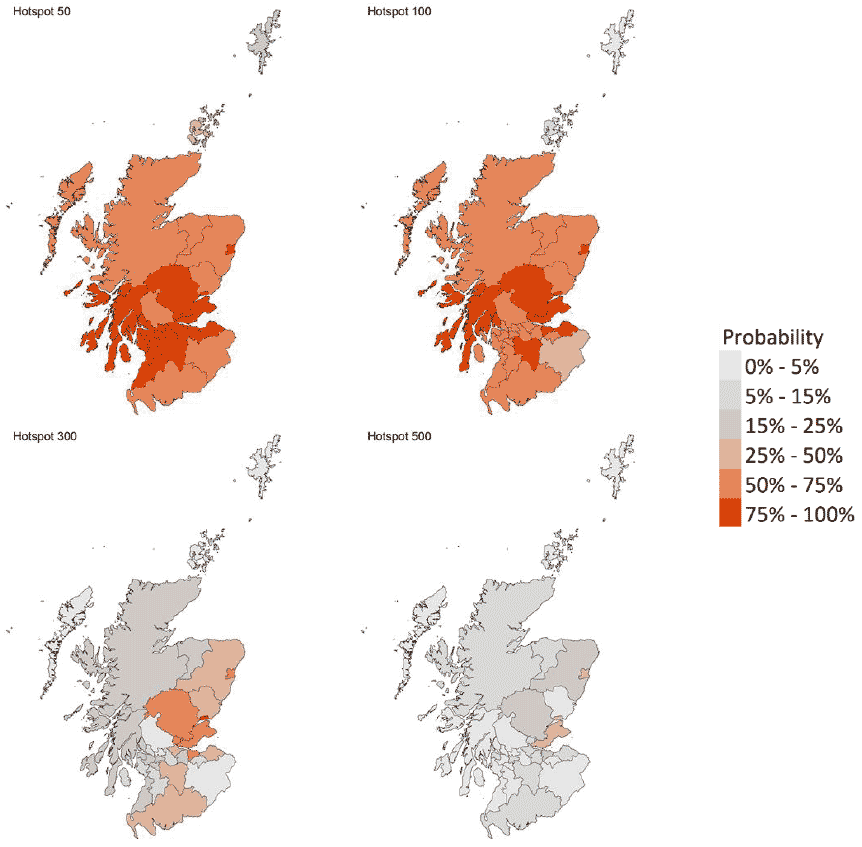
What can analysis of wastewater samples tell us about local outbreaks of Covid-19 infection?
Levels of Covid-19 RNA in wastewater (WW) collected at a number of sites around Scotland are adjusted for population and local changes in intake flow rate (or ammonia levels where flow is not available). See Technical Annex in Issue 34 of these Research Findings for the methodology.
Nationwide, wastewater (WW) Covid-19 levels has declined greatly from their peak just before the new year, with a decrease to around 50 million gene copies per person per day in the week ending 24th January.
Compared to the situation before December 2021, WW Covid-19 levels appear lower than anticipated given the known levels of Covid-19 activity. This effect may be due to the switchover from Delta variants to the new Omicron variant. Thus, Figure 26 shows only data from after the end of 2021, at which point the Omicron variant already represents the vast majority of cases in Scotland. From this, we see a rapid decline from peak levels in early January with a continued albeit slower decline up to this point.
Changes in PCR testing strategy is thought to have impacted statistics relating to the rate of new cases, though lateral flow device based case rates do also show a decline over the same period.
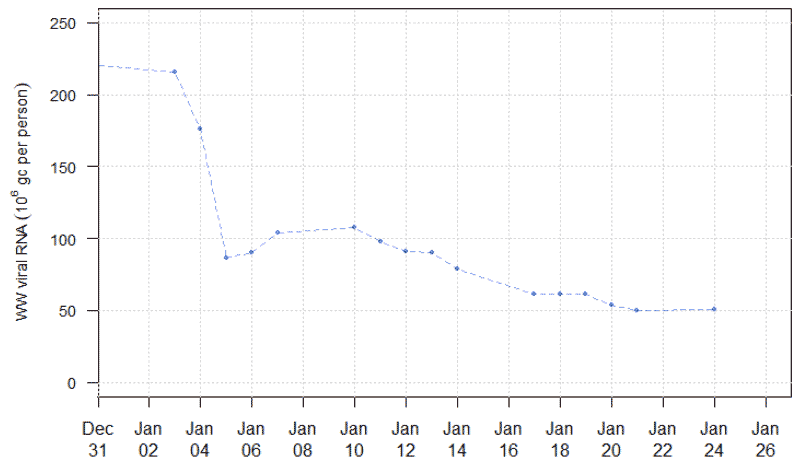
Comparing the weeks beginning 11th January and 18th January, there was an increase in Covid-19 levels in wastewater in 5 local authorities. This included Edinburgh, Dumfries & Galloway, East Lothian, Midlothian and West Lothian as shown in Table 2 in the Technical Annex.
What estimates do we have of the number of people experiencing long Covid symptoms?
The Scottish Government is modelling the number of people likely to experience long Covid symptoms. This gives a projection of estimated self-reported long Covid rates in the future, based on Scottish Government medium term projection modelling, as set out in Figure 27.
This modelling estimates that at 13th February 2022 between 63,000 (1.1% of the population) and 162,000 (3.0%) people are projected to self-classify with long Covid for 12 weeks or more after their first suspected Covid infection in Scotland.
These are preliminary results, further data on rates of long Covid and associated syndromes as research emerges are required.
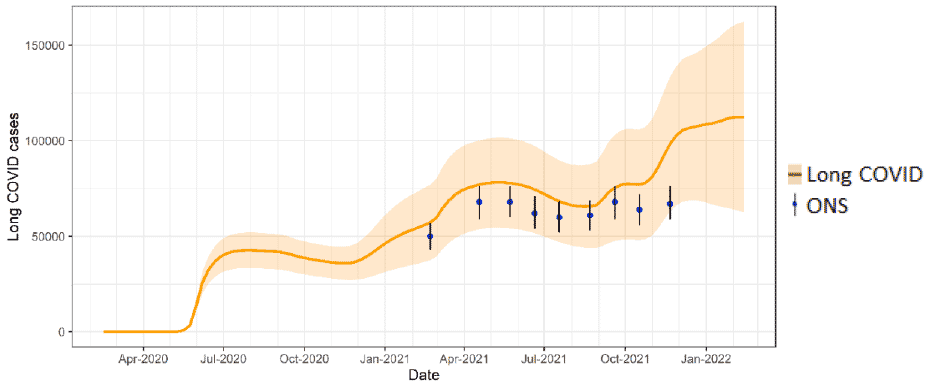
See the Technical Annex in issue 73 for information about the methodology.
What next?
Modelling will continue to look at the impacts of Omicron and residual Delta variants. As the year progresses we will incorporate different models as and when it is appropriate to do so.
Contact
There is a problem
Thanks for your feedback